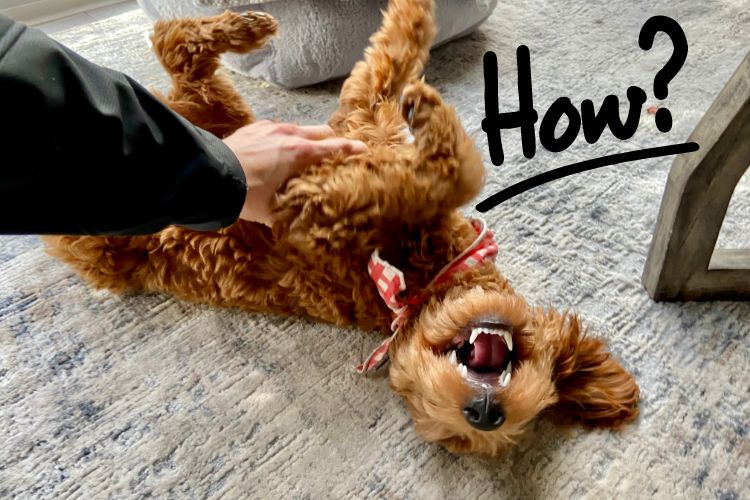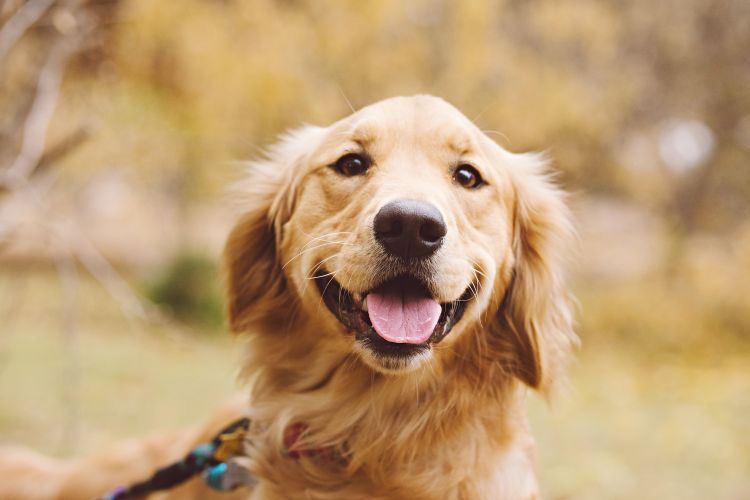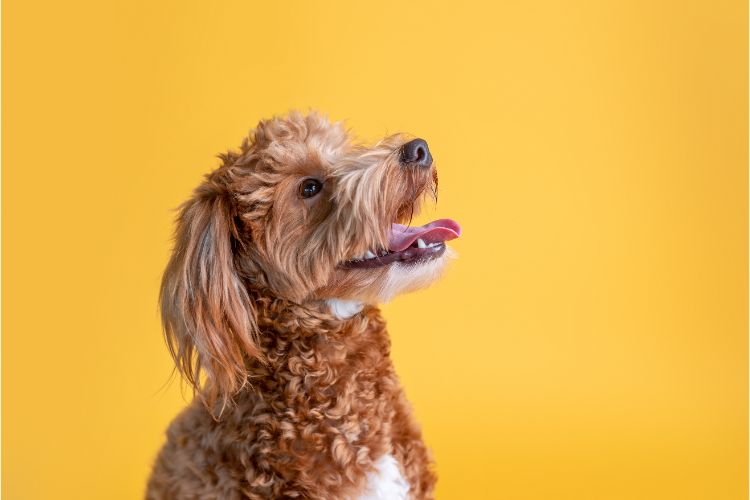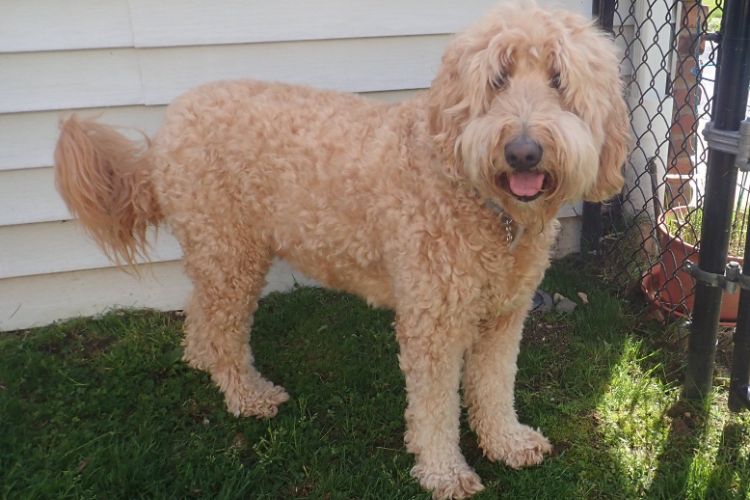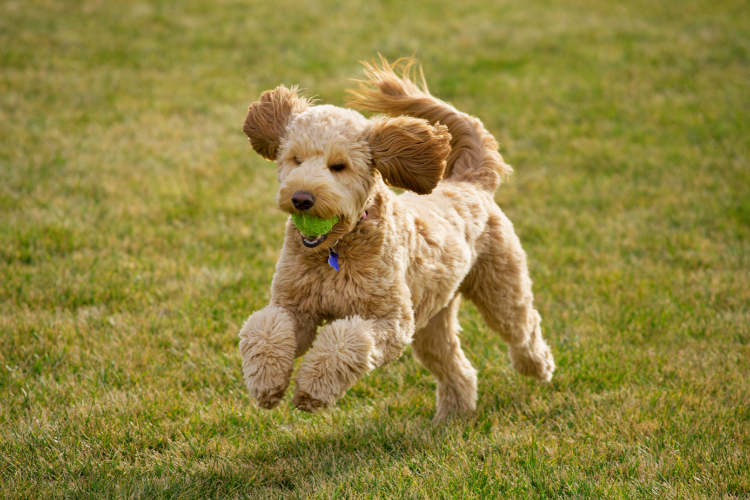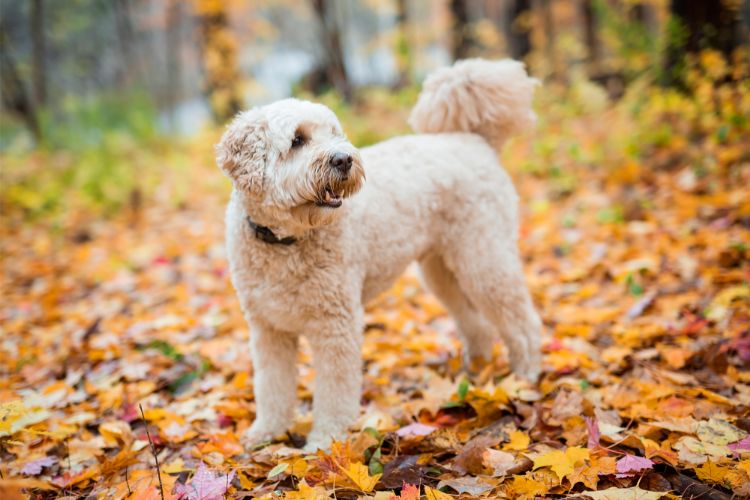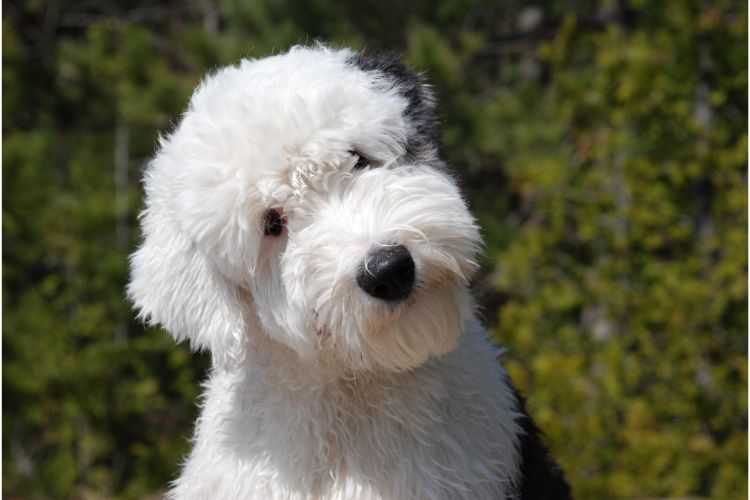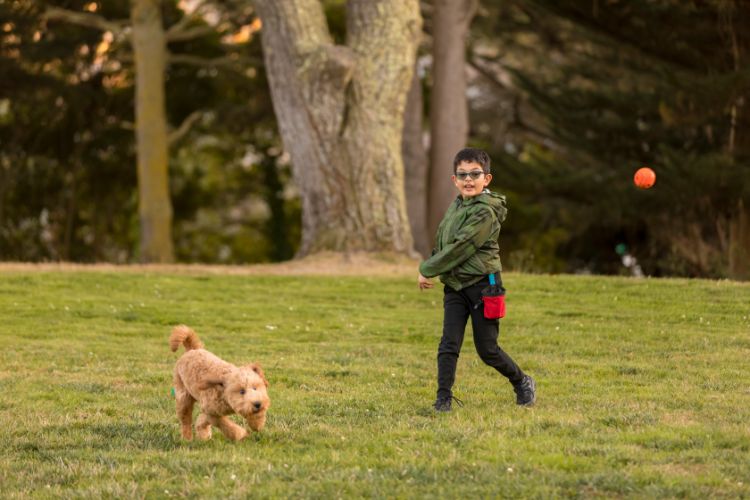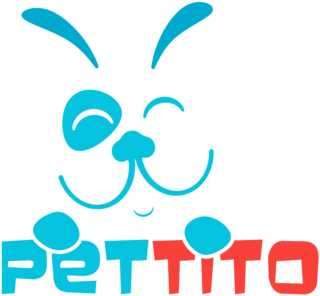Goldendoodles are known for their incredibly sweet temperaments and laid-back nature. With their ragamuffin look and sweet demeanor, they have become incredibly popular in recent years, and for good reason.
One of many reasons that people are drawn to this breed is because of their low shedding and hypoallergenic coats. Today, breeders don’t have to rely on the generation of the Goldendoodle to predict coat appearance or shedding intensity, so it’s easy to find the Goldendoodle of your dreams.
If you’re looking for a sweet-natured Goldendoodle puppy, we’ll show you what to look for and delve into what the different generations mean. We’ll also discuss what to look for when choosing a Goldendoodle puppy and provide valuable insights into their health predispositions, height, lifespan, coat colors, grooming needs, feeding requirements, exercise routines, and positive dog training needs.
Here’s the takeaway:
The Goldendoodle
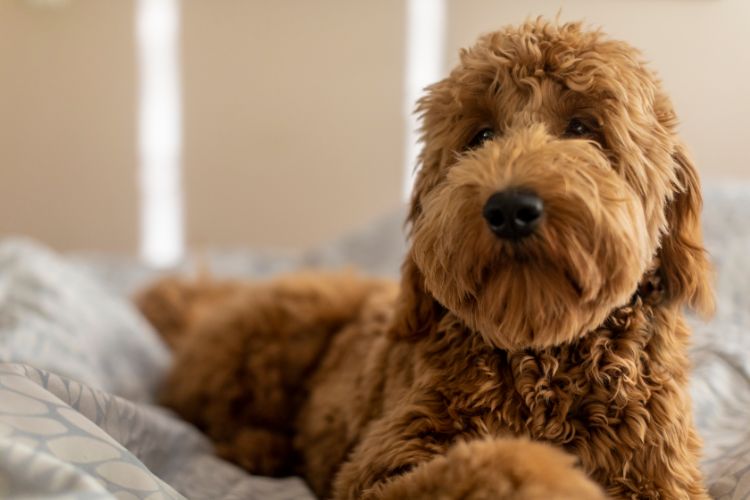
The Goldendoodle is a hybrid mix between a Golden Retriever and a Poodle, resulting in an intelligent, affectionate, and hypoallergenic breed. Best of all, they’re easy to train, enjoy being around children and pets, and are great companions for families and parents who enjoy the outdoors.
Goldendoodles, a crossbreed between a Golden Retriever and a Poodle, are known for their intelligence, affectionate nature, and hypoallergenic coat. They are highly trainable, enjoy the company of children and other pets and animals like cats and horses, and make excellent companions for families and outdoor enthusiasts.
Goldendoodles come in four sizes: petite, miniature, medium, and standard, providing options to suit different living situations and preferences. They have gained popularity as a designer dog breed since their development in the 1990s when breeders began marketing this social, non-aggressive breed.
This hybrid breed combines the best traits of both parent breeds, with the Golden Retriever’s friendly and gentle temperament and the Poodle’s hypoallergenic coat. Goldendoodles are energetic and playful, making them ideal family dogs. It’s important to note that while Goldendoodles are generally hypoallergenic, each dog may vary.
How to Choose a Goldendoodle Puppy?
If you’re looking for a well-bred, cute, and healthy Goldendoodle puppy, you should look for reputable Goldendoodle breeders and register your puppy with GANA. If your Goldendoodle puppy was not purchased from a GANA breeder, you can register pups with The Goldendoodle Registry (TGR) at www.GoldendoodleRegistry.com.
Goldendoodle Sizes
There are four size categories for Goldendoodles, each with its own height range and weight estimate:
- Petite Range: These Goldendoodles measure below 14 inches in height and typically weigh 25 lbs. or less.
- Miniature Range: Miniature Goldendoodles in this category stand over 14 but under 17 inches (35cm to 42cm) at the wither and generally weigh between 26-35 lbs.
- Medium Range: Goldendoodles in the medium size range measure over 17 but under 21 inches (43cm to 52cm) at the wither and typically weigh between 36-50 lbs.
- Standard Range: The largest Goldendoodles fall into the standard size range. They measure over 21 inches (53cm to 63cm) at the wither and typically weigh 51 lbs. or more.
It’s important to note that the final size of your Goldendoodle is determined at adulthood and is measured at the withers. While breeders may provide an estimated size for a puppy, it’s important to understand that these are educated guesses, and a puppy’s final size may vary somewhat from the initial estimation.
Understanding the Generations
The Goldendoodle Association of North America (GANA) says that the primary concern of any breeder is health, temperament, and conformation and that today, Goldendoodle breeders can now have litters with predictable coat types and shedding propensities. GANA will register the Goldendoodle offspring if the breeding pair comprises the breeds below.
- Poodle
- Golden Retriever
- Goldendoodle
F1 Generation
The F1 generation is the direct mix of a Golden Retriever and a purebred Poodle. This first-generation Goldendoodle typically has a wavy or slightly curly coat, making them less likely to trigger allergies. With their friendly and outgoing nature, they make excellent family pets and therapy dogs.
F2 Generation
The F2 generation refers to the crossbreeding of two F1 Goldendoodles. These pups can have various coat types, ranging from wavy to curly. Due to the increased genetic diversity, F2 Goldendoodles may display different characteristics, making it essential to consider individual temperament and coat type when choosing a puppy.
F3 Generation
The F3 generation results from breeding two F2 Goldendoodles together. With each successive generation, there is a greater likelihood of consistency in appearance and temperament. F3 Goldendoodles often have a more predictable coat type, which can be helpful for individuals with specific grooming preferences or allergies.
Health Predispositions
Goldendoodles are generally healthy, but it’s key to be aware of potential health issues. When choosing a puppy, inquire about health clearances for both parents, such as hip and elbow dysplasia, eye disorders, and genetic diseases. A reputable breeder will provide documentation to ensure you get a healthy Goldendoodle puppy.
PetMD says the Goldendoodle is a healthy breed first bred in the late 1960s. Their lifespan is around 10-15 years, but they may be prone to the health issues common to both parent breeds.
“Breeders should be thoroughly testing their breeding stock by performing OFA or PennHip testing on their hips, echocardiograms with a cardiologist, and extensive genetic testing before breeding,” explains PetMD.
Here are some of the health issues that your Goldendoodle may be genetically predisposed to:
- Hip dysplasia
- Heart disease like subvalvular aortic stenosis
- Congenital eye issues like cataracts and glaucoma
Height & Lifespan
Goldendoodles come in petite, standard, medium, and miniature sizes. Standards typically reach 20 to 24 inches in height, while miniatures range from 14 to 17 inches. Medium-sized Goldendoodles fall in between. Their lifespan can vary between 10 to 15 years, depending on genetics, diet, exercise, and overall care.
Coat Colors and Types
The diverse coat colors of Goldendoodles stem from the contributions of both parent breeds. Golden Retrievers only produce shades of cream, apricot, and red. These lighter colors are controlled by variants of the same gene determining hue intensity.
Poodles lend their black, brown, silver, gray, and multicolored coat patterns to Goldendoodle puppies. The interaction between color genes inherited from each parent breed leads to a broad spectrum of potential coat colors.
While Golden Retriever genetics limit their coat palette, Poodles contribute to darker pigmentations. Combinations of genetic variants from both parental lineages give Goldendoodles their uniquely vibrant and varied coloring.
The Unique Coat Patterns of Goldendoodles
Goldendoodles exhibit several distinct coat color patterns beyond solid shades:
- Parti coats have prominent white patches covering at least 50% of the body mixed with solid color patches.
- Abstract or mismark coats have more minor white markings covering less than 50%.
- Merle coats feature a marbled mix of light and dark pigment. Responsible breeding is crucial as merle gene pairs can cause blindness/deafness.
- Phantom coats have tan points – markings above the eyes, on the muzzle, chest, legs, and under the tail.
- Brindle coats have stripes in varying widths and colors.
The interactions between Poodle and Golden Retriever color genetics produce Goldendoodles with stunningly diverse and vibrant coat patterns. Reputable breeders carefully manage merle pairings to avoid health issues.
Coat Length (FGF5 Gene)
Although professional grooming every few weeks is best for this breed, the coat length gene- FGF5- determines coat length and whether your Golden has a long or short coat.
“Although long coats are recessive, because both Goldendoodle parent breeds are long-coated, all Goldendoodles carry two genes for long coat (L/L). Since short coat is dominant, if a dog carries a gene for the short gene (S/L) their coat would be short. This is why some Labradoodles have short coats in the early generations, whereas Goldendoodles do not,” explains GANA.
Curl Gene (KRT71) Gene
If you’re wondering whether your Golden will have a curly coat, Goldendoodles can have curly, wavy, or straight coats. Goldendoodles can also have different amounts of curl and inherit the curl gene from their parents.
Goldendoodles exhibit a range of coat textures from straight to wavy to curly. This variation is attributed to different combinations of the curl gene.
Typically, a Goldendoodle with a curly coat is homozygous for the curl gene (+/+). This means it inherited a curl gene from both parents.
A Goldendoodle with a flat or straight coat likely does not carry the curl gene at all (-/-). Dogs with a wavy or loose curl coat are heterozygous (+/-), meaning they inherited one curl gene and one straight gene.
Since wavy-coated Goldendoodles carry one curl gene, breeding two wavy dogs together can result in puppies with all three coat types – curly, wavy, and straight.
By testing the parent dogs, breeders can better predict the possible coat types of the litter. Understanding coat genetics allows them to produce Goldendoodles with the most desirable coat characteristics.
Furnishings
Furnishings are part of the Goldendoodle facial hair, including the famous Doodle mustache, eyebrows, tail, and beard, inherited from a specific gene.
These are some of the first things you’ll notice on a Goldendoodle. Previously, it was thought that the shedding gene and curl were key to a furnished dog shedding. Today, breeders use commercially available tests to test parent dogs for furnishing and curl genes genetically.
This is commonly abbreviated as:
- FF – Furnished coat (has furnishings)
- Ff or F IC – Improper coat (minimal furnishings)
- ff or IC IC – Little to no furnishings
The capital “F” represents the furnishing gene is present, while the lowercase “f” means absent. Puppies that inherit an “F” from both parents (FF) will have a fully furnished coat.
Those that inherit only one (Ff or F IC) will have reduced furnishings. And if neither parent passes on the furnishing gene (ff or IC IC), the dog will have an improper coat with very minimal furnishings.
Understanding this simple one-gene inheritance pattern helps breeders predict furnishing coverage in Goldendoodle puppies. When purchasing a Goldendoodle puppy, you should discuss breeding and health concerns.
Grooming Needs
With all the great grooming products out there, shopping for Goldendoodle grooming products is always fun. Goldendoodles require regular grooming with natural and organic Goldendoodle shampoos and conditioners to keep their coats clean, moisturized, and tangle-free.
Depending on the coat type, they may need brushing several times a week with a special Doodle slicker brush. Regular professional grooming appointments are also recommended for trimming, bathing, and maintaining a healthy coat. It’s also much easier to manage a Goldendoodle coat when regularly clipped.
Feeding Requirements
Choosing the right dog food is important for keeping your Goldendoodle healthy and happy. When selecting food, look for high-quality ingredients tailored to their nutritional needs. Many experts recommend The Farmer’s Dog as one of the best dog foods for Goldendoodles.
The Farmer’s Dog uses human-grade ingredients and customizes recipes based on your dog’s age, weight, and activity level. Meals are freshly made, frozen, and shipped directly to you.
This personalized approach provides balanced nutrition without fillers or preservatives.
Pet parents love the convenience and report improvements in their dogs’ skin, coat, energy levels, and digestive health. Veterinarians recommend not feeding excess protein or calories even with active Goldendoodles because this can lead to kidney disease and obesity.
PetMD says that every Goldendoodle pet parent should work with their veterinarian to calculate the right amount of food they should be feeding. They also add that Goldendoodles should be provided smaller amounts of food twice daily (pups three times daily) and should not be exercised for at least an hour after feeding to prevent bloat.
Other top-rated foods for Goldendoodles include Orijen, Merrick, Wellness Core, Blue Buffalo, and Royal Canin. However, today’s feeding trend is based on fresh and natural ingredients to promote optimal health.
Exercise and Training
Nothing is more fun than spending plenty of outdoor time hiking with your Goldendoodle and enjoying dog sports like agility, swimming, and playing fetch.
Goldendoodles are active dogs that require regular exercise to keep them mentally and physically stimulated. Daily walks, playtime, and interactive training sessions are essential for their well-being.
Positive reinforcement techniques like reward-based training work best with this intelligent and eager-to-please breed.
Activity Level
Your Goldendoodle is an active and playful breed that must exert energy, especially during puppyhood. Before purchasing or adopting a Goldendoodle puppy, ensure you have the time to go for long walks, participate in puppy obedience training, and engage in interactive play sessions.
Proper exercise is essential to keep your Goldendoodle physically and mentally stimulated. Regular exercise not only helps to keep your Goldendoodle fit but also promotes their overall well-being.
It can prevent behavioral issues from pent-up energy, such as excessive barking or destructive behavior. Engaging in physical activities with your Goldendoodle also strengthens your bond with your pup.
FAQs: What Should I Look for in a Goldendoodle?
Q: What is so special about the Goldendoodle?
A: Goldendoodles are easygoing and non-aggressive. They also get along well with small children and active pet parents who love the outdoors. Look for a puppy or adult dog with friendly and sociable behavior and a calm disposition. This is a hypoallergenic breed that has almost no shedding.
Q: Are Goldendoodles good with small children?
A: If you have small children or other pets, ensuring the Goldendoodle you choose gets along well with them is important. Look for a dog that has been socialized and shows a positive attitude toward other animals and children if you’re adopting a Goldendoodle. If you’re purchasing a puppy, ensure plenty of socialization and puppy training throughout puppyhood.
Difference Between F1 and F1B Goldendoodles
Video Credit: We Love Doodles


